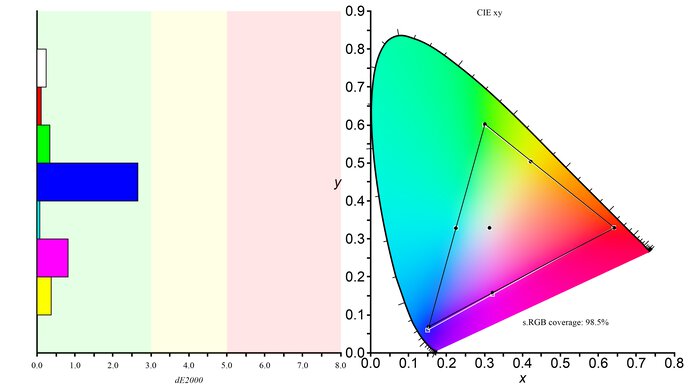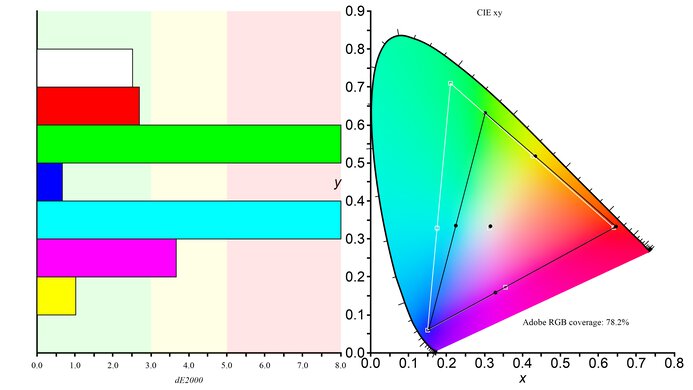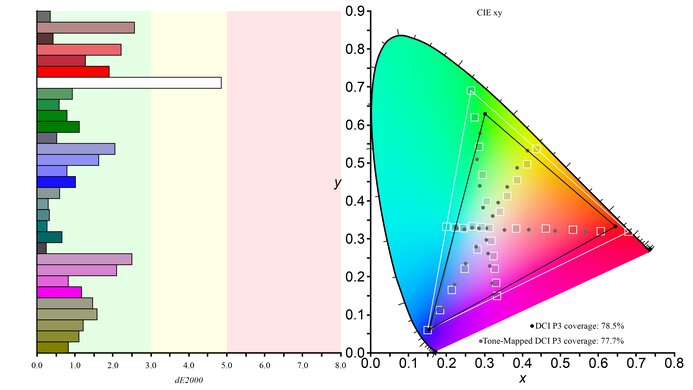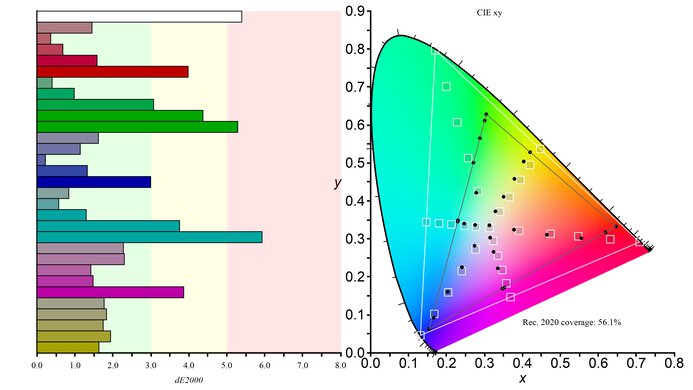The LG 32GN650-B/32GN63T-B is a 32-inch, 1440p budget gaming monitor from LG's UltraGear lineup. It's available in two variants at different retailers, with the only difference being that the 32GN650-B model has an extra HDMI port compared to the 32GN63T-B. They both have a maximum refresh rate of 165Hz and VRR support to reduce screen tearing. While each variant doesn't have many productivity features or USB connectivity, they do have some additional gaming features, like crosshair support, black stabilizer, dynamic contrast ratio, and a 3.5 mm audio port for connecting headphones or speakers.
Our Verdict
The LG 32GN650-B is okay for PC gaming. Its 165Hz refresh rate is good enough for most casual gamers, and it has VRR support to reduce screen tearing. It also has low input lag for a responsive feel, but there are some downsides for gaming. Motion is blurry due to its slow response time, and it has noticeable VRR flicker with changing frame rates. It also has limited picture quality as highlights don't pop in HDR and it lacks a local dimming feature, but it has a great native contrast ratio.
-
165Hz max refresh rate.
-
Low input lag.
-
Great native contrast ratio.
-
Noticeable smearing and motion blur.
-
Highlights don't pop in HDR.
-
No local dimming feature.
-
Distracting VRR flicker.
The LG 32GN63T-B.AUS is mediocre for console gaming. It can't take full advantage of the Xbox Series X|S and PS5 as it lacks HDMI 2.1 bandwidth, but there aren't any compatibility issues with either console. In terms of gaming, it has low input lag for a responsive feel, but fast-moving objects are blurry as it has a slow response time. That said, it fails to deliver realistic and vivid images as it lacks a local dimming feature to further improve on its great contrast ratio, and highlights don't pop in HDR.
-
Low input lag.
-
Great native contrast ratio.
-
Noticeable smearing and motion blur.
-
Highlights don't pop in HDR.
-
No local dimming feature.
-
Lack of HDMI 2.1 bandwidth.
The LG 32GN650-B is alright for office use. It has okay text clarity, and its 32-inch size is large enough to open multiple windows at the same time. It has decent brightness and reflection handling, and while it overcomes glare in most environments, it struggles with glare from strong light sources, like opposite a bright window. Also, in addition to having no swivel adjustment, images look washed out from the sides, making it difficult to share the screen with others.
-
Decent reflection handling.
-
Okay text clarity.
-
Can't swivel.
-
Not bright enough to fight intense glare.
The LG UltraGear 32GN63T-B is decent for media creation. It has okay text clarity, and its 32-inch size is large enough to open multiple windows at the same time. It's fine if you want to use it in a room with a few lights around as it has decent reflection handling, but it has narrow viewing angles, so it isn't ideal for sharing your screen with others. Luckily, it has great contrast, so it displays deep blacks next to bright highlights, but it lacks a local dimming feature to further improve it. However, it fails to display a wide range of colors in HDR, and you need to calibrate it in SDR for the most accurate colors.
-
Superb SDR color gamut.
-
Great native contrast ratio.
-
Decent reflection handling.
-
Limited HDR color gamut coverage.
-
Not bright enough to fight intense glare.
-
No local dimming feature.
-
No sRGB mode; needs full calibration.
The LG 32GN650-B has okay brightness. It's fine if you want to use it in a room with a few lights around, but it doesn't get bright enough to fight intense glare, and highlights don't pop in HDR.
-
Not bright enough to fight intense glare.
-
Highlights don't pop in HDR.
The LG 32GN63T has a disappointing response time. Motion looks blurry, and there's noticeable inverse ghosting as the refresh rate drops.
-
Noticeable smearing and motion blur.
The LG 32GN650-B has disappointing HDR picture quality. It has a great native contrast ratio to display deep blacks, but it lacks a local dimming feature to further improve it. It also has a limited color volume, so it can't display bright and dark colors well.
-
Great native contrast ratio.
-
Limited HDR color gamut coverage.
-
No local dimming feature.
The LG 32GN650 has very good picture quality in SDR. It displays a wide range of colors, and it has a high contrast ratio to display deep blacks in dark rooms.
-
Superb SDR color gamut.
-
Great native contrast ratio.
The LG 32GN650-B has great color accuracy. Although it's accurate before calibration, you still need to calibrate it for the most accurate colors.
-
Accurate before calibration.
-
No sRGB mode; needs full calibration.
- 6.6 PC Gaming
- 6.1 Console Gaming
- 6.9 Office
- 7.1 Editing
Performance Usages
- 6.7 Brightness
- 5.3 Response Time
- 5.4 HDR Picture
- 7.9 SDR Picture
- 8.3 Color Accuracy
-
Updated Mar 12, 2025:
Added that the Acer Nitro XZ322QU V3bmiiphx gets brighter in SDR.
- Updated Feb 21, 2025: Converted to Test Bench 2.0.1.
- Updated Aug 07, 2024: Updated text throughout the review according to Test Bench 2.0, mainly in the Verdict and Motion sections.
- Updated Aug 05, 2024: We've converted this review to Test Bench 2.0. This includes new tests for VRR Motion Performance, Refresh Rate Compliance, Cumulative Absolute Deviation (CAD), and VRR Flicker. You can read the full changelog here.
- Updated Feb 05, 2024: Updated the text to reflect changes with Test Bench 1.2.
- Updated Dec 15, 2023: Clarified the differences between this monitor and its variant, the LG 32GN63T-B, in the Variants section.
- Updated Apr 14, 2023: Confirmed that 1440p works on this monitor with the PS5.
- Updated Sep 02, 2022: Clarified the differences between this monitor and the recently-reviewed LG 32GN63T-B.
- Updated Aug 30, 2022: Added that it comes with a mouse holder in the box.
- Updated Jul 06, 2022: Updated to Test Bench 1.2, resulting in changes to the results and scores with the Response Time and Input Lag. Added tests for Console Compatibility and macOS compatibility and made minor changes to other tests, which you can see in our Changelog.
- Updated Feb 26, 2021: Review published.
- Updated Feb 22, 2021: Early access published.
- Updated Feb 17, 2021: Our testers have started testing this product.
- Updated Feb 15, 2021: The product has arrived in our lab, and our testers will start evaluating it soon.
- Updated Feb 08, 2021: We've purchased the product and are waiting for it to arrive in our lab.
Check Price
Differences Between Sizes And Variants
We tested the 32-inch LG 32GN650-B, part of LG's UltraGear gaming lineup. This model has a variant known as the LG 32GN63T-B, which is sold at different retailers and has only one HDMI port instead of two. The results of this review are valid for the 32GN650-B and the LG 32GN63T-B.
| Model | Size | Panel Type | Max Refresh Rate | HDMI Ports |
|---|---|---|---|---|
| 32GN650-B | 32" | VA | 165Hz | 2 |
| 32GN63T-B | 32" | VA | 165Hz | 1 |
The LG UltraGear 32GN650-B we tested was manufactured in November 2020. You can see our unit's label here.
Compared To Other Monitors
The LG 32GN650-B is a budget 32-inch gaming monitor that's a good alternative to most 27-inch, entry-level monitors if you want something bigger, but it doesn't offer anything special. It has blurry motion, and you can get other low-cost monitors with better motion handling, like the LG 32GP850-B/32GP83B-B.
For more options, see our recommendations for the best budget and cheap gaming monitors, the best 1440p gaming monitors, and the best 32-inch monitors.
The LG 32GN650-B/32GN63T-B and the LG 32GN600-B are nearly identical. The only significant difference between them is the stand. The 32GN650-B has a more advanced stand with much better ergonomics, so adjusting it to an ideal viewing position is easier.
The LG 32GP850-B/32GP83B-B and the LG 32GN650-B/32GN63T-B are 32-inch, 1440p gaming monitors that use different panel technologies, each with advantages and disadvantages. The newer 32GP850 uses an IPS panel, and it has better viewing angles, better reflection handling, higher peak brightness, and a much better response time, so it's more versatile for most uses. The 32GN650 uses a VA panel and has better contrast, making it a better option for a dark room.
The LG 32GN650-B/32GN63T-B and the Acer Nitro XZ322QU V3bmiiphx are 32-inch 1440p gaming monitors. The Acer is the better option for competitive gamers, as it has much better motion handling. It's also a better choice for gaming in a bright room, as it gets much brighter. However, if you're on a budget the LG can be a good option, as it's in a lower price range.
The LG 32GN650-B/32GN63T-B and the LG 27GN850-B/27GN880-B use different panel types with different advantages. The 32GN650-B is much better for dark room gaming thanks to its high-contrast VA panel, but the IPS panel on the 27GN850-B has wider viewing angles that are better for co-op gaming. That said, the 27GN850-B has some advantages that might make it a better option if you don't need a larger screen. Both are 1440p monitors, but the smaller size of the 27GN850-B means it has a greater pixel density, resulting in a crisper image. It also has significantly faster response times for clear motion.
The Dell S3222DGM is slightly better than the LG 32GN650-B/32GN63T-B. The Dell has a faster response time, especially when gaming at 60Hz, but the LG has a slightly better stand, as it can switch to a portrait orientation. The LG supports HDR, but can't display a true HDR experience, so this doesn't add much.
The Dell S3221QS and the LG 32GN650-B/32GN63T-B are both good 32-inch monitors, although each is better suited to different uses. As a gaming monitor, the LG has a 165Hz panel, a much faster response time, and a lower input lag. The Dell, on the other hand, is limited to a 60Hz refresh rate. That said, the Dell has a 4k resolution that ensures a crisp image despite the larger size, so it's well-suited to multitasking and anything that requires a lot of screen real estate. The Dell also gets brighter and has better reflection handling, so it's more suited to well-lit rooms.
The LG 32GN650-B/32GN63T-B and the LG 32GK650F-B are similar monitors, but the 32GN650-B has some extra features that make it a better choice. The biggest difference is its 165Hz refresh rate, compared to the 144Hz of the 32GK650F-B. The 32GN650-B has a faster response time and a lower input lag, offering slightly better gaming performance. The only downside is that the 32GN650-B doesn't swivel at all, resulting in a little worse ergonomics. All in all, though, the 32GN650-B is a solid step up at a similar price.
Test Results
The ergonomics are decent. It's fine if you want to adjust the screen for yourself, but without swivel adjustment, it's hard to turn the screen to show someone else. The back of the monitor is simple, with a red circle similar to other UltraGear monitors. The stand features a clip for cable management.
This monitor doesn't have a local dimming feature. We still film these videos on the monitor so you can compare the backlight performance with a monitor that has local dimming.
The SDR brightness is decent. It gets bright enough to fight glare in most well-lit rooms, though it struggles to overcome glare in very bright situations like the sun shining on it. Additionally, its brightness stays consistent across different content. These results are from after calibration in the 'Gamer 1' Picture Mode with the Brightness at its max. If you're looking for a monitor that gets even brighter, check out the Acer Nitro XZ322QU V3bmiiphx.
The brightness in HDR is mediocre. Without a local dimming feature, it doesn't make highlights pop in HDR. It displays most scenes at their correct brightness because the monitor follows the PQ EOTF curve fairly well. These results are from the 'Gamer 2' Picture Mode, with HDR enabled and Brightness at its max.
The horizontal viewing angle is disappointing. The image looks washed out from the sides, making sharing content with a friend or co-worker more difficult.
The vertical viewing angle is disappointing, and the image is inconsistent if you stand up and look down at the monitor.
The monitor has great accuracy before calibration. Most colors have slight inaccuracies, but the color temperature is close to ideal. Though without an sRGB mode, colors are oversaturated. Gamma doesn't follow the target very closely, so it doesn't display most scenes at their correct brightness as they're either too bright or too dark.
The accuracy after calibration is superb, and doing so fixes most inaccuracies. The color temperature is almost perfect, and gamma follows the curve extremely well.
The SDR color gamut is fantastic. The monitor has near-perfect coverage of the commonly used sRGB color space. However, it has more limited coverage of the Adobe RGB color space with undersaturated green and cyan.
| NVIDIA | VRR Min | VRR Max |
| DisplayPort | <20Hz | 165Hz |
| HDMI | N/A | N/A |
| AMD | VRR Min | VRR Max |
| DisplayPort | <20Hz | 165Hz |
| HDMI | <20Hz | 144Hz |
| Refresh Rate | CAD Heatmap | RT Chart | Pursuit Photo |
| 164 | Heatmap | Chart | Photo |
| 144 | Heatmap | Chart | Photo |
| 120 | Heatmap | Chart | Photo |
| 100 | Heatmap | Chart | Photo |
| 80 | Heatmap | Chart | Photo |
| 60 | Heatmap | Chart | Photo |
The motion handling is disappointing across the VRR range. There's noticeable smearing and blur, and there's more inverse ghosting at lower refresh rates. Although the 'Faster' overdrive setting is the best at high refresh rates, the 'Fast' setting is more consistent across the VRR range. The other settings have such high CAD that it passes the limits of the chart, and you can see an alternative chart here.
The refresh rate compliance is poor. Its response time isn't fast enough to make full color transitions before the monitor draws the next frame, leading to blurry motion.
| Overdrive Mode | CAD Heatmap | RT Chart | Pursuit Photo |
| Off | Heatmap | Chart | Photo |
| Normal | Heatmap | Chart | Photo |
| Fast | Heatmap | Chart | Photo |
| Faster | Heatmap | Chart | Photo |
The CAD at the max refresh rate of 165Hz is disappointing. There's noticeable blur and smearing, even with the 'Faster' overdrive setting. The other settings have less inverse ghosting than 'Faster,' but they have more blur.
| Overdrive Mode | CAD Heatmap | RT Chart | Pursuit Photo |
| Off | Heatmap | Chart | Photo |
| Normal | Heatmap | Chart | Photo |
| Fast | Heatmap | Chart | Photo |
| Faster | Heatmap | Chart | Photo |
The CAD at 120Hz is disappointing. Like at the max refresh rate, the recommended overdrive is 'Faster' as it has less blur than the other settings, but it still has smearing and inverse ghosting.
| Overdrive Mode | CAD Heatmap | RT Chart | Pursuit Photo |
| Off | Heatmap | Chart | Photo |
| Normal | Heatmap | Chart | Photo |
| Fast | Heatmap | Chart | Photo |
| Faster | Heatmap | Chart | Photo |
The CAD at 60Hz is poor. The 'Fast' overdrive has noticeable smearing and inverse ghosting. You can use 'Normal' if the inverse ghosting bothers you, but it has more blur.
The input lag is low, so you won't notice any delay and get a responsive feel.
Unfortunately, there are some issues when using this monitor with macOS. The VRR feature flickers both in-game and on the desktop when the frame rate drops below 60 fps, and HDR doesn't work. When using a MacBook, windows return to their original position when waking the laptop up from sleep, though not when reopening the lid.
The LG UltraGear 32GN650 has a few extra features, including:
- Crosshair: Adds a virtual crosshair for FPS games.
- On-Screen Display Lock: Locks the on-screen display settings.
- Black Stabilizer: Increases the gamma in dark scenes to make details more visible.
- Dynamic Contrast Ratio: Adjusts the brightness of the screen automatically.
- Reader Mode: Reduces blue light emissions to reduce eye strain.
Comments
LG 32GN650-B/32GN63T-B: Main Discussion
Let us know why you want us to review the product here, or encourage others to vote for this product.
- 21010
Just got this in the mail. It seems someone at Braun read your review, because they now sell the base model with a chopping accessory and two blades for it: an actual blade, and blunt “ice chopping blade”. Made myself a coarse snowcone with it, works well. However I’m a little bewildered by the implementation of accessories: every attachment has a gearbox to step down the max speed. Maybe also increases the torque? But the gearbox on every accessory is a significant source of noise. In particular the purée attachment is very loud- so much so that I wonder if the gearbox is broken. I wish the testing methodology included at least a note on the attachments!
Hey Aelius!
Thanks for bringing this to our attention. I looked into it and you’re right, this model does come with a food processing attachment which seems like it could be useful for chopping ice. Unfortunately, we no longer have this model in our inventory so we can’t do any further testing on any of the other accessories that came with it. We will take your feedback for future test methodology updates and we really appreciate your feedback as we rely on it to continuously improve our testing.
Thanks again and have a great day!
- 21010
Just got this in the mail.
It seems someone at Braun read your review, because they now sell the base model with a chopping accessory and two blades for it: an actual blade, and blunt “ice chopping blade”.
Made myself a coarse snowcone with it, works well.
However I’m a little bewildered by the implementation of accessories: every attachment has a gearbox to step down the max speed. Maybe also increases the torque?
But the gearbox on every accessory is a significant source of noise. In particular the purée attachment is very loud- so much so that I wonder if the gearbox is broken.
I wish the testing methodology included at least a note on the attachments!
Update: Updated text to match Test Bench 1.0.


























































































































